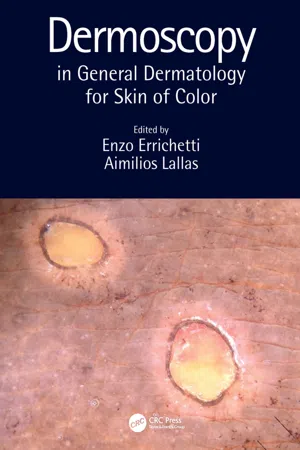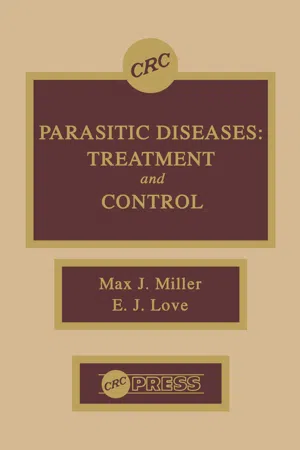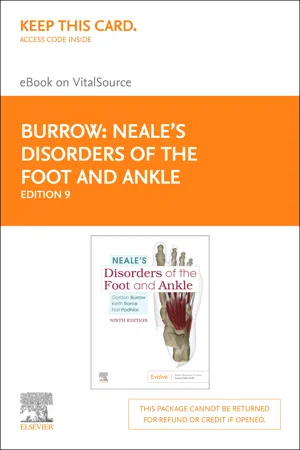Biological Sciences
Leprosy
Leprosy, also known as Hansen's disease, is a chronic infectious disease caused by the bacterium Mycobacterium leprae. It primarily affects the skin, peripheral nerves, and mucous membranes, leading to skin lesions and nerve damage. Leprosy is transmitted through respiratory droplets and close contact with an infected individual, and early diagnosis and treatment are crucial in preventing disability and further transmission.
Written by Perlego with AI-assistance
11 Key excerpts on "Leprosy"
- eBook - ePub
- Christopher E. M. Griffiths, Jonathan Barker, Tanya O. Bleiker, Robert Chalmers, Daniel Creamer, Christopher Griffiths, Jonathan Barker, Tanya Bleiker, Robert Chalmers, Daniel Creamer(Authors)
- 2016(Publication Date)
- Wiley-Blackwell(Publisher)
CHAPTER 28 Leprosy Diana N. J. Lockwood London School of Hygiene & Tropical Medicine, London, UKDefinition and nomenclature
A chronic granulomatous disease caused by Mycobacterium leprae, principally affecting peripheral nerves and skin.Synonyms and inclusions
- Hansen's disease
- Hanseniasis
- Names in local languages in endemic areas
Introduction and general description
Endemic in India and the Far East since ancient times, Leprosy was imported into Europe in the 4th century BC, perhaps by the troops of Alexander the Great. The European epidemic peaked in the 13th century, then slowly died out [1]. French settlers took Leprosy to Canada and African slaves took it to America. Even after the discovery of the agent, Mycobacterium leprae, by Armauer Hansen in Norway in 1873 (the first bacillus to be associated with a human disease), the infectious nature of Leprosy was not readily accepted [2]. The slow spread of the disease and its familial association suggested that it was inherited. This belief, and the fear of the deformities that Leprosy may cause, have contributed to the stigma and ostracization that still characterize attitudes towards Leprosy. Stigma remains a major obstacle to Leprosy control, despite advances in bacteriology, chemotherapy and epidemiology. New patients today can be reassured that their bacterial infection is readily treatable with antibiotics although associated nerve damage is more difficult to treat.Epidemiology
Incidence and prevalence
About 4 million people have, or are disabled by, Leprosy. The apparent fall in registered patients from 12 million in 1988 to 0.25 million on treatment in 2014 hides an intriguing picture. Prevalence has fallen due to a combination of effective antibiotic therapy and a change in case definition. Incidence, however, remains stable at around 250 000 new cases annually, with high rates of childhood cases [3]. - Enzo Errichetti, Aimilios Lallas, Enzo Errichetti, Aimilios Lallas(Authors)
- 2021(Publication Date)
- CRC Press(Publisher)
Part IIInfectious diseasesPassage contains an image
Balachandra Ankad, Vinay Keshavamurthy, Shekhar Neema, Payal Chauhan and Enzo Errichetti9Bacterial infectionsDOI: 10.1201/9780367816483-99.1 Leprosy
9.1.1 Introduction
Leprosy, also known as Hansen’s disease, is a chronic granulomatous disease caused by Mycobacterium leprae that typically affects the skin, mucous membranes (e.g., nose), peripheral nervous system, eyes and testes.1 ,2Several disease phenotypes are possible based on the patient’s immunity, with more severe forms occurring in subjects with a less effective immune response to the infection.1 ,29.1.2 Clinical presentation
The main clinical subtypes of Leprosy include indeterminate, tuberculoid, borderline tuberculoid, borderline borderline, borderline lepromatous and lepromatous Leprosy; lepra bonita (diffuse skin infiltration) and histoid Leprosy are rarer forms.1 ,2During the course of the infection, immunologically mediated episodes of acute or subacute inflammation known as “lepra reactions” (type 1 and type 2) may occur.1 ,2Tuberculoid Leprosy (Figure 9.1A ) presents with single or multiple, asymmetric, well-defined, erythematous plaques with raised and clear-cut edges sloping inward and a dry, anaesthetic and hairless surface, with or without scales.1 ,2Lesions can flatten over time with hypochromic centre. It is associated generally with solitary nerve thickening.1 ,2- eBook - ePub
Tuberculosis, Leprosy and other Mycobacterial Diseases of Man and Animals
The Many Hosts of Mycobacteria
- Harshini Mukundan, Mark Chambers, Ray Waters, Michelle Larsen, Harshini Mukundan, Mark Chambers, Ray Waters, Michelle Larsen(Authors)
- 2015(Publication Date)
- CAB International(Publisher)
26 Mycobacterium leprae in HumansJohn S. Spencer,1 * William H. Wheat,1 Patrick J. Brennan,1 Josafá G. Barreto2 and Claudio G. Salgado 21 Colorado State University, Fort Collins, Colorado 2 Pará Federal University, Marituba, Brazil*E-mail: [email protected]Leprosy: A Chronic Disease of Skin and Nerves
Leprosy is a chronic mycobacterial infection caused by the obligate intracellular pathogen Mycobacterium leprae that mainly damages skin and peripheral nerves, causing a broad array of skin lesions, peripheral neuropathy and anaesthesia with related disfigurement, deformity and disability along with the social stigma intimately associated with this ancient disease (Scollard et al., 2006 ). The remarkable inter-individual variability in clinical manifestations of Leprosy closely parallels the hosts’ abilities to mount effective immune responses to M. leprae, dependent on the interplay of both cell-mediated and humoral responses. This is evidenced by the overall resistance toward developing Leprosy in the majority of individuals who are infected, accompanied by high cellular immune reactivity against M. leprae. In addition, the variability in immune responses to M. leprae is also clear from the well-known immunological and clinical Leprosy spectrum in those who progress to disease, ranging from tuberculoid (TT) or borderline tuberculoid (BT), or paucibacillary (PB) Leprosy to lepromatous (BL/LL) or multibacillary (MB) Leprosy. The concept that the range of clinical and histopathological manifestations represented a spectrum of disease states was first proposed by Skinsnes (1964 ). The division of the forms of disease was categorized using the Madrid system (Davison et al., 1960 ), followed by the more commonly used Ridley–Jopling classification scheme (Ridley and Jopling, 1966 ). The Ridley–Jopling classification system is divided into five distinct forms bounded by two immunological extremes. At the polar tuberculoid end of the spectrum (TT), patients have a very strong cell-mediated immune response, usually having a single hypopigmented lesion with loss of sensation within the border. Histologically, there is a clear-cut well-organized granulomatous response consisting of epithelioid cells and lymphocytes with no or few acid-fast bacilli detectable in stained tissue sections. TT and borderline tuberculoid (BT) patients in general show high cellular responses to M. leprae antigens in vitro as measured by the production of Th1 cytokines, particularly IFNg, and have low antibody titres to M. leprae-specific antigens. At the polar lepromatous end of the spectrum (LL), patients have essentially lost all capacity to respond to M. leprae antigens due to T cell anergy and have high antibody titres to M. leprae antigens, particularly the M. leprae-specific glycolipid, PGL-I (Hunter and Brennan, 1981 ; Spencer and Brennan, 2011 ), and with disseminating progressive infection that manifests itself with numerous poorly defined raised or nodular lesions that can occur anywhere on the body. Histological examination reveals a disorganized granuloma filled with ‘foamy’ macrophages in the dermis filled with huge numbers of acid-fast bacilli and rafts of bacilli called globi. These distinctive cells are filled with vesicles containing mainly host-derived lipids organized as lipid bodies (Mattos et al., 2010 ; de Mattos et al., 2012 ), a likely nutritional source for M. leprae and first described in lepromatous lesions by Virchow (1863 ). The borderline states (BT/BB/BL) are positioned in-between, and reflect immunologically rather unstable phenotypes. The different outcomes of M. leprae - eBook - ePub
- Jo Robertson(Author)
- 2022(Publication Date)
- Hurst Publishers(Publisher)
INTRODUCTIONThere is hardly anything on earth, or between it and heaven, which has not been regarded as the cause of Leprosy; and this is but natural, since the less one knows, the more actively does his imagination work. And since all that was known of Leprosy was that it was a loathsome disease, search was made everywhere for a cause.1– Gerhard Henrik Armauer Hansen and Carl LooftMycobacterium leprae was identified by G. H. Armauer Hansen in 1873 to be the bacillus consistently present in the nodes of Leprosy patients.2 But this was far from the last word on the disease, for this entity still continues to puzzle histologists, pathologists, geneticists, and clinicians. This powerful and elusive bacterium that stalked through mediaeval Europe, inexplicably disappearing in the West and reappearing at the end of the nineteenth century in the colonies, still defies researchers. Medically, it is the aristocrat of diseases – the oldest, and the most aloof. Its ancient genome is described as degenerate since it has discarded many of its pathways and pared itself down to only what it needs to survive. Its effects depend more upon the reaction of the host than upon the action of the invader.3 Its stages and categories have always been subject to confusion and debate. How it enters the body and is transmitted to others are still unknown. Its history is also shrouded in an uncertainty that is heightened by the confusion and debate surrounding its naming. Its progress within the body is still only partly understood. It has managed to maintain its huge reputation despite an economy of effort: by multiplying slowly, infecting only a few.Persistent efforts have been made to understand, treat, and even eliminate this disease. This book charts those efforts from a number of different perspectives: the experiences of the patients, the evolution in understanding of what the disease was and how it might be contained, the ingenious science deployed to advance knowledge of the bacterium, the sources of funding of the fight against the disease, and the complex politics underlying international attempts to systemise the attempt to control and even eliminate the disease. First, though, I discuss the cultural freight of Leprosy, a disease recorded in classical and biblical times, which over the centuries accreted a symbolic potency that continued to be felt in some measure even to the present. The focus of the book is on the development of treatment regimens from approximately 1948 to 2005, the period when scientific discoveries, international post-war politics, and changes in sources of funding all contributed to a reassessment of what a “cure” of Leprosy meant, and how and where patients should be treated. I introduce the story by describing the partial understanding of the disease and its appropriate treatment in the first half of the twentieth century. No effective cure was known, and some of the attempted treatments such as ingestion of chaulmoogra oil created nothing but enormous distress for the patient. - eBook - ePub
The Architecture and Landscape of Health
A Historical Perspective on Therapeutic Places 1790-1940
- Julie Collins(Author)
- 2020(Publication Date)
- Routledge(Publisher)
7 Isolating the individualLeprosaria and Hansen’s disease
Leprosaria, leper hospitals, Leprosy asylums, or lazarets, as they were variously known, were designed to house those suffering from Leprosy, an infectious bacterial disease. The disease presented itself as a disfiguring skin condition and carried a social stigma meaning sufferers were often isolated from the rest of the population sometimes for the remainder of their lives. The isolation and segregation of those afflicted with Leprosy occurred in colonies, leprosaria or smaller stand-alone buildings. Such buildings were characterised by their scale, ventilation, occasional sole occupant accommodation and separation from society. During the nineteenth century, the building of leprosaria intensified not from any increase in the spread of the disease or an improved understanding of it, but due to fears surrounding tropical environments and an intensification of race-based discourse.Leprosy
Leprosy is a chronic infectious bacterial disease caused by Mycobacterium leprae , yet it is still unclear exactly how the disease is transmitted. Historically, it was believed to have been transmitted by skin to skin contact between infected and healthy people. However, more recently, transmission via droplets, from the nose and mouth, or during close and frequent contact with untreated cases have been thought to be the likely causes (World Health Organization 2019b). With an incubation period of up to five years, the disease predominantly affects the skin, the peripheral nerves, mucosa of the upper respiratory tract and the eyes, and if left untreated, Leprosy can cause permanent damage to the skin, nerves, limbs and eyes. The stigma which many Leprosy sufferers experienced was common across the world and, as Robertson noted, the diseasereduced its victims to pauper status, irrespective of their pre-Leprosy lives. In addition to Leprosy altering the physical body, especially the face and hands, thereby compromising individuality, a diagnosis of the disease brought about a traumatic alteration in a person’s social status and identity. - eBook - ePub
- Peter Lydyard, Michael Cole, John Holton, Will Irving, Nino Porakishvili, Pradhib Venkatesan, Kate Ward(Authors)
- 2023(Publication Date)
- CRC Press(Publisher)
The socioeconomic impact of Leprosy continues to be a burden in endemic countries. Rehabilitation strategies for Leprosy should contain physical, psychological, social, and economic aspects. Up to now, most Leprosy control programs have been focused on physical rehabilitation only. Socioeconomic rehabilitation has been introduced by some local governments, nongovernmental organizations (NGOs), and community-based rehabilitation (CBR) programs focused on the patient’s self-awareness and combating the stigma attached to the disease. These are specifically adapted for the local needs and differ among countries and from area to area.SUMMARY
1. WHAT IS THE CAUSATIVE AGENT, HOW DOES IT ENTER THE BODY, AND HOW DOES IT SPREAD A) WITHIN THE BODY AND B) FROM PERSON TO PERSON?- ■ For many years, Mycobacterium leprae was considered as a sole pathogen causing Leprosy. However, in 2008, Mycobacterium lepromatosis was identified as second causative agent of Hansen’s disease (HD). M. lepromatosis has been implicated in a small number of HD cases, and clinical aspects of the disease caused by M. lepromatosis are not yet clearly defined. M. lepromatosis was initially associated with diffuse lepromatous Leprosy, but subsequent studies have linked it to other forms of HD.
- ■ M. leprae and M. lepromatosis comprise a so-called “Mycobacterium leprae complex”.
- ■ Mycobacterium leprae is the most frequent causative agent of Leprosy. It is an obligate intracellular gram-positive bacillus that requires the environment of the host macrophage for survival and propagation by binary fission.
- ■ It shows preferential tropism toward macrophages and Schwann cells that surround the axons of nerve cells.
- ■ M. leprae is a straight or curved rod-shaped organism, 1–8pm long and approximately 0.3 μm in diameter.
- ■ An intracellular parasite, M. leprae cannot be cultured by conventional laboratory methods and can be propagated in mouse footpad or in its natural host – the nine-banded armadillo.
- ■ The genome of M. leprae, contains less than 50% of the functional genes of M. tuberculosis. These lost genes coding for the metabolic pathways have been replaced in M. leprae by pseudogenes or inactivated genes, and it is even more dependent on host metabolism for survival than M. tuberculosis
- eBook - ePub
Sex, Dissidence and Damnation
Minority Groups in the Middle Ages
- Jeffrey Richards(Author)
- 2013(Publication Date)
- Routledge(Publisher)
8 LepersThere is perhaps no disease in history which has given rise to such fear and loathing as Leprosy. The very term ‘leper’ has become a synonym for outcast. In the Middle Ages this reaction arose in part from the physical deformities, suppurating sores and noxious odour caused by the disease. But even more it derived from the certain knowledge that Leprosy was the outward and visible sign of a soul corroded by sin and in particular by sexual sin.It is now known that Leprosy is a contagious disease caused by the bacillus Mycobacterium Leprae, which is related to the tuberculosis bacterium. It is spread through personal contact, abrasions and insect bites. It has a lengthy incubation period, sometimes running into years, and there is a high natural resistance to it. This natural resistance can be seriously undermined by poor diet, bad housing and unhealthy living conditions; hence the incidence of the disease in under-developed areas like medieval Europe and the present-day Third World. The disease emerged in both high and low resistance forms. Low resistance Leprosy is characterized by lumps and patches on the skin, which develop into sores; damage to the eyes, resulting in blindness; hoarseness of the voice as the throat is affected. High resistance means that the skin is not seriously disfigured but the nervous system is damaged, muscles are paralysed and feeling is lost. Limbs become deformed and the mutilation of fingers and toes frequently occurs.Today Leprosy can be cured; in the Middle Ages it was incurable. The influential fourteenth-century physician and medical writer Guy de Chauliac recorded: ‘It is agreed by all that Leprosy is a very injurious disease … and is almost impossible to eradicate.’ Although there was an attempt to divide Leprosy into types, based on an imbalance of the humours, earth, air, fire and water, this did not relate to the variations in the disease now recognized and for the most part ieprosy’ was one of the Middle Ages’ catch-all terms like ‘scrofula’ and ‘putrid fever’, covering a multitude of conditions. It was difficult in the early stages to distinguish between genuine Leprosy and a wide variety of other skin conditions, notably impetigo, psoriasis, dermatitis ‘Raynaud’s disease, scabies and fungal infections. Given the poor hygiene and diet endemic in the period, skin infections were quite common. But usually they did not lead to the physical deformities characteristic of Leprosy proper. - eBook - ePub
Parasitic Diseases
Treatment & Control
- Max J. Miller, Edgar Love(Authors)
- 2020(Publication Date)
- CRC Press(Publisher)
LeprosyPassage contains an image
Chapter 38
NEW DISCOVERIES OF SIGNIFICANCE TO THE PREVENTION, CONTROL, AND TREATMENT OF Leprosy
R. C. Hastings
TABLE OF CONTENTS
I. Overview II. Clinical Leprosy III. Pathology of Leprosy IV. Microbiology of Leprosy V. Experimental Infections of Leprosy VI. Rehabilitation of Leprosy VII. Chemotherapy of Leprosy REFERENCESI. OVERVIEW
I would like to focus on new discoveries of significance to Leprosy treatment in the broad sense of management of a Leprosy patient, both from a practical and basic science point of view. I will limit my remarks to developments which, in my judgment, are significant in the last 5 years or so. The overall areas to be covered will include:1. Clinical Leprosy 2. The pathology of Leprosy3. The microbiology of Mycobacterium leprae4. Experimental infections with M. leprae5. The rehabilitation aspects of Leprosy 6. The chemotherapy of LeprosyII. CLINICAL Leprosy
In the field of clinical Leprosy over the last 5 years, there is a growing awareness, in my judgment, that the many phenomena of autoimmunity such as antinuclear antibodies, thyroglobulin antibodies, rheumatoid factor activities in the serum, circulating immune complexes, etc., are in fact epiphenomena and are not related to the primary pathogenesis of the patient’s signs or symptoms in Leprosy. In many cases, these seem merely to be the result of polyclonal gammapathy.1Secondly, in the clinical field increased emphasis has now been placed on the nose as a portal of exit of Leprosy bacilli or Mycobacterium leprae in untreated disseminated or so-called multibacillary cases. On the other hand, it has been demonstrated that the nose is cleared of bacilli relatively rapidly after chemotherapy is begun. Surprisingly, the nose remains essentially clear of bacilli despite even irregular antiLeprosy chemotherapy.2 Thus, a likely source of M. leprae for new infections is probably the nose of untreated multibacillary cases, and after chemotherapy is instituted, in all probability, the treated patient becomes essentially noninfectious. As a separate issue, the nose has been demonstrated in experimental animals, namely, nude mice, to be the likely portal of entry of M. leprae into a new host.3 - eBook - ePub
- Gérard Said, Christian Krarup(Authors)
- 2013(Publication Date)
- Elsevier(Publisher)
Jennekens and Van Brakel, 1998 ).Fig. 28.1 (A ) Both hands affected by Leprosy. (B ) Deformity in the right foot. Note absorption of the first and second toes.Leprosy has been recognized since the ancient civilizations of China, Egypt, and India. The oldest description of Leprosy probably dates back to 600 B.C. At that time, it used to be considered a divine punishment for sins according to the Old Testament and to karma in the Buddhist religion. In 1874, a Norwegian physician Gehrard Henrik Armauer Hansen (1841–1912) (Hansen, 1874 ) identified the causal agent of this illness, at a time when Leprosy was endemic in Norway. Although documented since ancient times, Leprosy remains endemic to several regions, especially in subtropical and tropical ones.Epidemiology
The World Health Organization (WHO) planned to reduce the prevalence of Leprosy to 1 per 100 000 inhabitants in 2000 (WHO, 1982 ). During 2008, more than 1000 new cases were reported in 17 countries: India, Brazil, Indonesia, Democratic Republic of Congo, Bangladesh, Nigeria, Nepal, Ethiopia, Myanmar, Tanzania, Philippines, Sri Lanka, Sudan, Madagascar, China, Mozambique, and Angola. These countries account for 94% of the new cases detected globally during 2008 (WHO, 2009 ). According to the report, the number of newly detected cases was 249 007 in 2008, or a 3.5% decrease compared to 2007 (Declercq, 2009 ).Leprosy continues to be an important health problem worldwide but is most prevalent in India, Brazil, Indonesia, and Nigeria. India accounts for 64% of worldwide cases (Sabin et al., 2005 ). Although significant progress has been made in controlling Leprosy and reducing the burden of the disease much remains to be done in order to sustain the gains made and further reduce the disease burden (Noorden, 2003 ). It appears to have almost disappeared in China and Korea, thanks to improved public health services more than to specific treatment. Owing to emigration mainly from underdeveloped countries, the incidence of Leprosy is increasing in the USA (Sabin et al., 2005 - eBook - ePub
- William R. Faber, Roderick J. Hay, Bernard Naafs, William R. Faber, Roderick J. Hay, Bernard Naafs(Authors)
- 2012(Publication Date)
- Wiley-Blackwell(Publisher)
In 2006 the World Health Organization declared that Leprosy had been “eliminated” as a “public health problem.” This would have been a huge achievement if it was true. However, it is shown that changing operational and administrative targets played a decisive role in achieving the elimination targets. Definitions have been changed and treatment periods shortened. Leprosy services have been dismantled and integrated into the general health services without proper training and follow-up [1,4]. To date the true prevalence of the disease is in some areas more than twice the registered [5]. With the increase in and the extent of mobile populations in the world it is a disease to reckon with, a disease that may lead to severe disabilities when not diagnosed in time and not treated properly. Doctors' delay is a big problem in Europe and the United States [6,7]. Moreover, it is so in many of the Leprosy endemic countries too, where Leprosy is often hardly taught at Medical Schools [8].Increasingly, Leprosy shows as an immune reconstitution inflammatory syndrome (IRIS): seropositive HIV patients infected with M. leprae , when treated with ARVs, recover their cell-mediated immunity and then develop clinical Leprosy, indicating that there may be a pool of M. leprae of unknown size [9].Until 2005, Leprosy was the disease to be eliminated; now it is counted among the neglected diseases. EpidemiologyLeprosy is still endemic in Middle and South America, in Africa south of the Sahara, and in Asia from Iran to Indonesia, on some islands in the Pacific, and in the northern territory of Australia. (Figure 8.1 ) More than 85% of the Leprosy patients live in the following countries: India, Brazil, Indonesia, Nepal, Mozambique, Madagascar, United Republic of Tanzania, Democratic Republic of the Congo, and Central Africa.Figure 8.1 Leprosy prevalence rates, data reported in January 2011 (reproduced from Leprosy prevalence rates, data reported to WHO as of beginning January 2011, with permission WHO)Leprosy is an infectious disease caused by an intracellular acid-fast bacterium: M. leprae . In 1873, Armauer Hansen was the first to describe the bacterium as the cause of Leprosy, instigated by the work of Drognat Landré, a Dutch physician working in Suriname, who from his observations concluded that Leprosy must be a contagious disease [10]. However the postulates of Koch have still not been fulfilled. It has not yet been possible to infect someone willfully with M. leprae - eBook - ePub
- J. Gordon Burrow, Keith Rome, Nat Padhiar(Authors)
- 2020(Publication Date)
- Elsevier(Publisher)
Gray et al 1990 ). Direct inoculation into the foot presents with similar clinical findings to those found in infections of the upper limb. The disease manifests as a localised progressive swelling with variable pain, and the appearance, of nodular or verrucous skin lesions on the affected area within a few weeks. These lesions can show ulceration and bleeding not only from the disease process itself but also from mechanical trauma. The nodular lesions, measuring from a few millimetres up to 2–3 cm, may resolve spontaneously after a few months, but they can also disseminate proximally by haematogenous or lymphatic spread. The dorsal aspects of the foot and the malleolar regions are exposed to trauma; therefore, direct inoculation commonly takes place on these regions. Once the condition is suspected, microbiological and histopathological investigations represent the most sensitive tests to confirm the clinical diagnosis.LeprosyAdvanced disease manifests with skin atrophy, pigmentary changes and, in severe cases, chronic ulceration leading to disability (Fig. 14.9 ). Mutilating lesions of the toes result from bone resorption, mechanical trauma and secondary bacterial infection.The clinical diagnosis of Leprosy can be easily established in most cases that occur in endemic regions of the world (Bryceson & Pfaltzgraff 1990 ). Epidemiological, clinical, histopathological, bacteriological and immunological criteria have been used for many years to diagnose and classify the cases of Leprosy within a disease spectrum. This spectrum considers two polar groups or forms, called tuberculoid and lepromatous, as well as intermediate forms of the disease, defined as borderline. Early disease may not present characteristics of any of the above groups and such cases are called indeterminate. Patients with early disease, and particularly those presenting to the podiatrist in countries non-endemic for Leprosy, often pose diagnostic difficulties. The delay in establishing an accurate diagnosis and treatment inevitably results in irreversible nerve damage and chronic complications with variable degrees of disability.Skin tuberculosisThis affects individuals of all ages and both sexes who present with a wide variety of clinical pictures that frequently affect the lower limbs, particularly one or both feet (Chopra & Vega-López 1999
Index pages curate the most relevant extracts from our library of academic textbooks. They’ve been created using an in-house natural language model (NLM), each adding context and meaning to key research topics.
Explore more topic indexes
Explore more topic indexes
1 of 6
Explore more topic indexes
1 of 4










